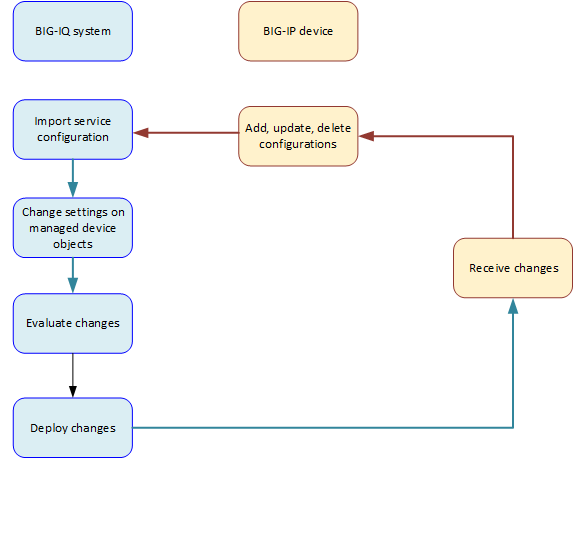Applies To:
Show Versions
BIG-IQ Centralized Management
- 5.1.0
How to manage ongoing configuration change
If you make changes on a BIG-IP® device before you have deployed the configuration from the BIG-IQ® system, configuration conflicts can occur. If conflicts do exist, when you deploy the configuration from the BIG-IQ system, you will have to choose between the configuration on the BIG-IQ or on the BIG-IP. You cannot keep both.

Ongoing change
How does re-import impact the device-specific resources?
When you re-import the APM® service configuration, the process adds and deletes any device-specific resources that were added and deleted on the source device for the Access group. The process, however, does not overwrite any existing device-specific resources on the BIG-IQ® system.
Device-specific resources are processed like this whether you import the APM service configuration from the Device Management user interface, or if you use the Re-import Source option for an Access group.
Guidelines for making changes to the Access configuration
These are general guidelines for updating the configuration:
- You should make any needed change that you can from the Access user interface.
- If you still need to make changes, you should make them on the BIG-IP® source device.
See the table for more specific guidelines.
| Resource | Description |
|---|---|
| Access: Device-specific resource |
|
| Access: Shared resource | Add, modify, and delete shared resources on the source device. Then re-import the service configuration into the BIG-IQ system. |
| Access: Pools and pool members | You can add and update pools and pool members when you configure some AAA servers in Access. Any changes you make are immediately available in ADC. To deploy these changes, you must deploy ADC before you deploy APM. |
| ADC: Pools and pool members | If you use ADC to add, update, or delete pools or pool members, you can create conflicts with the Access configuration. If you make changes in ADC, they are not available from Access. |
| ADC: Route domains and self-IP addresses | To add or edit route domains and self-IP addresses, do so in ADC. To make the changes available in Access, deploy the LTM® working configuration and then reimport the LTM configuration to the BIG-IQ system, |
| ADC: Virtual servers | Access configuration objects do not refer to virtual servers; however, you
probably want to know how to configure them. You can add and edit virtual servers in
ADC, but you can configure Access-specific settings, such as specifying an access
profile, only on the BIG-IP system. You can add or edit virtual servers in either of
these ways:
|
| ADC: iRule, nodes, interfaces, routes, VLANs, DNS resolvers | Access configuration objects do not refer to these objects directly. You do not need to worry about conflicts in the Access configuration. |





